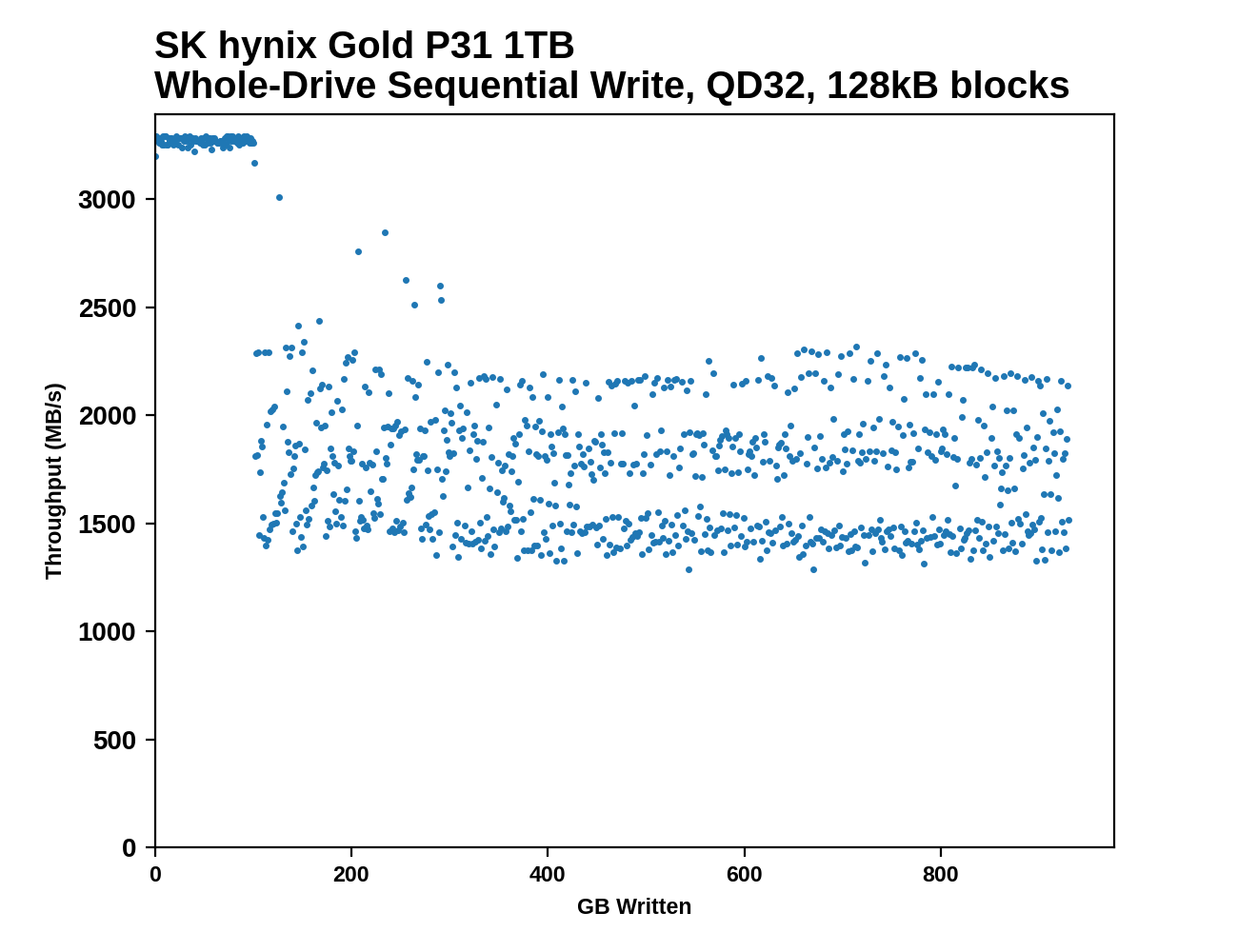The Best NVMe SSD for Laptops and Notebooks: SK hynix Gold P31 1TB SSD Reviewed
by Billy Tallis on August 27, 2020 8:00 AM ESTWhole-Drive Fill
This test starts with a freshly-erased drive and fills it with 128kB sequential writes at queue depth 32, recording the write speed for each 1GB segment. This test is not representative of any ordinary client/consumer usage pattern, but it does allow us to observe transitions in the drive's behavior as it fills up. This can allow us to estimate the size of any SLC write cache, and get a sense for how much performance remains on the rare occasions where real-world usage keeps writing data after filling the cache.
 |
|||||||||
The SLC write cache in the 1TB SK hynix Gold P31 runs out after just over 100GB of writes. After the SLC cache fills up, the Gold P31's sequential write performance becomes highly variable, ranging from about 1.4 to 2.3 GB/s with little change in character across the entire TLC filling phase. There are no obvious patterns of periodic garbage collection cycles visible at this scale.
 |
|||||||||
| Average Throughput for last 16 GB | Overall Average Throughput | ||||||||
Despite the variability, the P31's long-term sustained write performance is excellent. It averages out to the best overall write throughput we've measured from a 1TB TLC drive, and in all that variation the performance never drops down to a disappointing level.
Working Set Size
Most mainstream SSDs have enough DRAM to store the entire mapping table that translates logical block addresses into physical flash memory addresses. DRAMless drives only have small buffers to cache a portion of this mapping information. Some NVMe SSDs support the Host Memory Buffer feature and can borrow a piece of the host system's DRAM for this cache rather needing lots of on-controller memory.
When accessing a logical block whose mapping is not cached, the drive needs to read the mapping from the full table stored on the flash memory before it can read the user data stored at that logical block. This adds extra latency to read operations and in the worst case may double random read latency.
We can see the effects of the size of any mapping buffer by performing random reads from different sized portions of the drive. When performing random reads from a small slice of the drive, we expect the mappings to all fit in the cache, and when performing random reads from the entire drive, we expect mostly cache misses.
When performing this test on mainstream drives with a full-sized DRAM cache, we expect performance to be generally constant regardless of the working set size, or for performance to drop only slightly as the working set size increases.
 |
|||||||||
As expected for a drive with a full size DRAM buffer, the P31's random read latency is unaffected by spatial locality: reading across the whole drive is just as fast as reading from a narrow range. And the only other TLC drives that can match this read latency are the two Toshiba/Kioxia SSDs with 96L BiCS4 TLC NAND, but they can't maintain this performance across the entire test.










80 Comments
View All Comments
Srikzquest - Thursday, August 27, 2020 - link
Ok thanks Billy. I am going to get this. I have a 960 EVO in my laptop which I will transfer it to my Desktop (which doesn't use an NVMe SSD currently) and replace that with this in my laptop.lmcd - Thursday, August 27, 2020 - link
Good plan -- make sure though that your laptop mobo supports a new enough NVMe version! 960 was one 1.X release earlier.Billy Tallis - Thursday, August 27, 2020 - link
There are very few ways that NVMe could have trouble with forwards compatibility. I don't think any of them apply to features necessary to boot an OS, or to consumer drives in general. Almost all new stuff in recent NVMe versions has been optional features that your motherboard would never need to use, and your operating system can get by without.vladx - Thursday, August 27, 2020 - link
So most of the newer NVME protocols are enterprise only?Billy Tallis - Thursday, August 27, 2020 - link
It's been a mix of enterprise-only features and embedded-only features. Some of the more enterprise-oriented features would be slightly useful on consumer systems, but only in a world where consumers weren't held back by Windows and its lack of good storage admin tools.lmcd - Thursday, August 27, 2020 - link
I guess 99% of laptops are probably fine but I needed a BIOS update for my Lenovo E485 to accept an EVO 970, afaik. Or maybe I'm mixing it up with my desktop motherboard. All I know is that compatibility hasn't been as consistent as you'd expect.Srikzquest - Friday, August 28, 2020 - link
Thanks Imcd for the headsup as my current laptop is also a Lenovo one, T470. So, I will keep my eyes open.MikeMurphy - Friday, August 28, 2020 - link
I think the low power consumption should also help with thermals, though it's a stretch to think of a typical workload that would keep an NVMe SSD under load for very long.Hul8 - Thursday, August 27, 2020 - link
The ADATA XPG SX8200 Pro 1TB is missing from the list of included comparison drives on page 1.I only noticed because I was disappointed by its omission (I have one), but then found it in the graphs anyways.
Billy Tallis - Thursday, August 27, 2020 - link
Thanks for pointing that out. I've added it to the list on page 1.